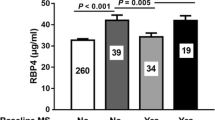Abstract
Retinol binding protein 4 (RBP4) is an adipokine involved in the pathogenesis of insulin resistance in obese adults and children. Since insulin resistance occurs during puberty, independently of adiposity, a role for RBP4 in the onset of this phenomenon may be hypothesized. In order to verify our hypothesis, we studied 90 subjects (45 obese and 45 lean controls). A complete physical examination was assessed, the z-score body mass index (BMI) was calculated, fat mass was assessed by bioelectric impedance analysis, and pubertal stage was assessed according to Tanner. Serum insulin and serum RBP4 levels were assayed. Obese and lean children differed for z-score BMI, fat mass, homeostasis model assessment of insulin resistance (HOMA-IR) and RBP4 levels. z-score BMI and HOMA-IR showed a direct correlation with RBP4 in the total population. When the subjects were divided in lean and obese, this correlation was evident only in obese (r2: 0.2; p=0.009 and r2: 0.2; p=0.01), but not in lean subjects (r2: 0.09; p=0.1 and r2: 0.03; p=0.4). Both in obese and lean HOMA-IR values were higher in pubertal subjects than in pre-pubertal (p<0.001), while serum RBP4 levels were similar in pubertal and in pre-pubertal subjects (>0.1). We conclude that RBP4 is correlated with adiposity and insulin resistance in obese children, but it is not involved in the insulin resistance occurring during puberty.
Similar content being viewed by others
References
Lee JM, Okumura MJ, Davis MM, Herman WH, Gurney JG. Prevalence and determinants of insulin resistance among U.S. adolescents: a population-based study. Diabetes Care 2006, 29: 427–32.
Caprio S, Bronson M, Sherwin RS, Rife F, Tamborlane WV. Co-existence of severe insulin resistance and hyperinsulinaemia in preadolescent obese children. Diabetologia 1996, 39: 1489–97.
Moran A, Jacobs DR Jr, Steinberger J, et al. Insulin resistance during puberty: results from clamp studies in 357 children. Diabetes 1999, 48: 2039–44.
Caprio S, Cline G, Boulware S, et al. Effects of puberty and diabetes on metabolism of insulin-sensitive fuels. Am J Physiol 1994, 266: E885–91.
Goran MI, Gower BA. Longitudinal study on pubertal insulin resistance. Diabetes 2001, 50: 2444–50.
Ball GD, Huang TT, Gower BA, et al. Longitudinal changes in insulin sensitivity, insulin secretion, and beta-cell function during puberty. J Pediatr 2006, 148: 16–22.
Hoffman RP, Vicini P, Sivitz WI, Cobelli C. Pubertal adolescent malefemale differences in insulin sensitivity and glucose effectiveness determined by the one compartment minimal model. Pediatr Res 2000, 48: 384–8.
Travers SH, Jeffers BW, Bloch CA, Hill JO, Eckel RH. Gender and Tanner stage differences in body composition and insulin sensitivity in early pubertal children. J Clin Endocrinol Metab 1995, 80: 172–8.
Moran A, Jacobs DR Jr, Steinberger J, et al. Insulin resistance during puberty: results from clamp studies in 357 children. Diabetes 1999, 48: 2039–44.
Ball GD, Huang TT, Gower BA, et al. Longitudinal changes in insulin sensitivity, insulin secretion, and beta-cell function during puberty. J Pediatr 2006, 148: 16–22.
Goran MI, Ball GD, Cruz ML. Obesity and risk of type 2 diabetes and cardiovascular disease in children and adolescents. J Clin Endocrinol Metab 2003, 88: 1417–27.
Graham TE, Yang Q, Blüher M, et al. Retinol-binding protein 4 and insulin resistance in lean, obese, and diabetic subjects. N Engl J Med 2006, 354: 2552–63.
Yang Q, Graham TE, Mody N, et al. Serum retinol binding protein 4 contributes to insulin resistance in obesity and type 2 diabetes. Nature 2005, 436: 356–62.
Balagopal P, Graham TE, Kahn BB, Altomare A, Funanage V, George D. Reduction of elevated serum retinol binding protein in obese children by lifestyle intervention: association with subclinical inflammation. J Clin Endocrinol Metab 2007, 92: 1971–4.
Aeberli I, Biebinger R, Lehmann R, L’allemand D, Spinas GA, Zimmermann MB. Serum retinol-binding protein 4 concentration and its ratio to serum retinol are associated with obesity and metabolic syndrome components in children. J Clin Endocrinol Metab 2007, 92: 4359–65.
Tanner JM, Whitehouse RH. Clinical longitudinal standards for height, weight, height velocity, weight velocity, and stages of puberty. Arch Dis Child 1976, 51: 170–9.
Cole TJ. The LMS method for constructing normalized growth standards. Eur J Clin Nutr 1990, 44: 45–60.
Luciano A, Bressan F, Zoppi G. Body mass index reference curves for children aged 3–19 years from Verona, Italy. Eur J Clin Nutr 1997, 51: 6–10.
Santoro N, Perrone L, Cirillo G, et al. Effect of the melanocortin-3 receptor C17A and G241A variants on weight loss in childhood obesity. Am J Clin Nutr 2007, 85: 950–3.
Santoro N, Cirillo G, Amato A, et al. Insulin gene variable number of tandem repeats (INS VNTR) genotype and metabolic syndrome in childhood obesity. J Clin Endocrinol Metab 2006, 91: 4641–4.
Gavi S, Stuart LM, Kelly P, et al. Retinol-binding protein 4 is associated with insulin resistance and body fat distribution in nonobese subjects without type 2 diabetes. J Clin Endocrinol Metab 2007, 9: 1886–90.
Vitkova M, Klimcakova E, Kovacikova M, et al. Plasma levels and adipose tissue messenger ribonucleic acid expression of retinolbinding protein 4 are reduced during calorie restriction in obese subjects but are not related to diet-induced changes in insulin sensitivity. J Clin Endocrinol Metab 2007, 92: 2330–5.
Tamori Y, Sakaue H, Kasuga M. RBP4, an unexpected adipokine. Nat Med 2006, 12: 30–1.
Chiarelli F, Giannini C, Mohn A. Growth, growth factors and diabetes. Eur J Endocrinol 2004, 151 (Suppl): U109–17.
Yamauchi J, Osawa H, Takasuka T, et al. Serum resistin is reduced by glucose and meal loading in healthy human subjects. Metabolism 2008, 57: 149–56.
Author information
Authors and Affiliations
Corresponding author
Rights and permissions
About this article
Cite this article
Santoro, N., Perrone, L., Cirillo, G. et al. Variations of retinol binding protein 4 levels are not associated with changes in insulin resistance during puberty. J Endocrinol Invest 32, 411–414 (2009). https://doi.org/10.1007/BF03346477
Accepted:
Published:
Issue Date:
DOI: https://doi.org/10.1007/BF03346477




